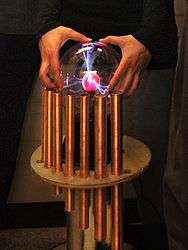Tritare
A tritare[1] is an experimental guitar invented in 2003 by mathematicians Samuel Gaudet and Claude Gauthier of the Université de Moncton of a family of stringed instruments which use Y-shaped strings, instead of the usual linear strings. Y-shaped strings can produce sounds which are harmonic integer multiples, but also nonharmonic sounds more akin to those produced by percussion instruments.[2][3][4] When tuned correctly, the Y-strings create Chladni patterns. Depending on how each note is played, Gaudet explains that non-harmonic ingredients can be included and offer a richer sound than a classical stringed instrument.[2][3] However the value of this greater possibility has been questioned by physicist and acoustics specialist Bernard Richardson of Cardiff University, who considers the branched string as just a simple analogue of complex structures with curved shells such as bars, cymbals, bells, and gongs, and claims that the tritare sounds bad.[2][3]
The model uses 6 strings and was commercially available for a short period. The sound effects achieved with the instrument are similar to the sounds that can be achieved with the 3rd bridge playing technique.
References
- ↑ Pronounced to rhyme with guitar. The prefix tri indicates that each string has 3 branches. The final e is by analogy with the French spelling guitare.
- 1 2 3 Weiss, Peter String Trio: Novel instrument strums like guitar, rings like bell, Science News, Week of June 3, 2006; Vol. 169, No. 22, p. 342
- 1 2 3 Extra Strings for New Sounds Sohn, Emily, Student Science, June 7, 2006
- ↑ S.Gaudet and S.Léger, A New Family of Stringed Musical Instruments, presented at Acoustical Society of America 2006 June 6
| ||||||||||||||||||||||||||||||||||||||
